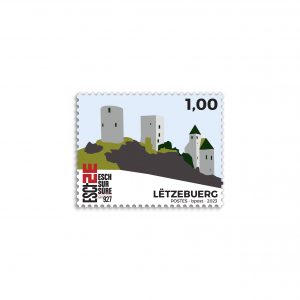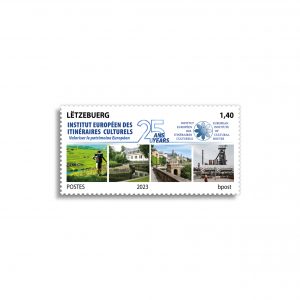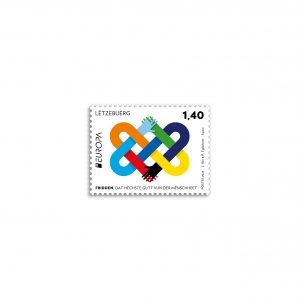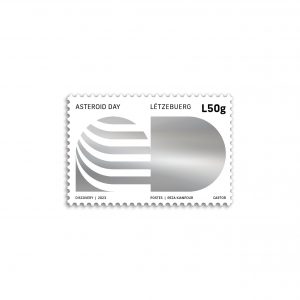POST Luxembourg is issuing a new series of stamps on the 16th of May 2023
A special stamp is honoring the small village of Esch-sur-Sûre which first appeared on an official document dated 3 June 927.
Furthermore, a second stamp will be commemorate the 200th anniversary of Edmond de la Fontaine, better known by his pen name “Dicks”.
He is one of the leading lights of Luxembourgish literature as well as one of the pioneers of the country’s theatre scene.
Another special stamp will celebrate the 100 years of the “Gëlle Fra”, one of Luxembourg’s most important monuments
standing on the “place de la constitution” in the heart of Luxembourg City.
Moreover, POST Luxembourg is issues a special stamp for the 25 year anniversary of the European Institute of Cultural Routes,
established in 1998 in the framework of a political agreement between the Council of Europe and the Grand Duchy of Luxembourg.
This year’s EUROPA stamp is dedicated to “Peace- the highest value of humanity”. The symbol on this stamp will be shared by all Posteurop members and has been created by the Luxembourgish designers Linda Bos and Runa Egilsdottir.
Last but not least, the second motif of the Asteroid Day special series, which POST Philately is issuing over a three-year period, illustrates the theme of “Discovery”.
Special stamp
ESCH23, “Esch-sur-Sûre säit 927”
Lying in a valley of the river Sûre in the northern Luxembourg region of Oesling, the commune of Esch-sur-Sûre dates back over 1,000 years. Under the banner “ESCH23” this year, Esch-sur-Sûre is hosting a number of cultural events designed to showcase the commune and give visitors plenty to discover.
The first mention of Esch-sur-Sûre appeared in a document dated 3 June 927. In this act, a certain Maingaud and his wife Hiltrud acquired land in Esch-sur-Sûre as well as a farm in Eschdorf in an exchange with the Abbey of Stavelot. It was on a rocky hillside that they built the original castle, which had a square layout. Today, the ruins of Esch-sur-Sûre castle remain a dominant feature of the picturesque landscape.
The “Duchfabrik” (cloth factory) another well-known cultural institution in Esch-sur-Sûre. The museum tells the story of the Esch-sur-Sûre weavers’ guild, which was founded in the 16th century and where handmade woollen products are still produced to this day.
The impressively preserved lanes dating from medieval times and the location in the Upper Sûre Natural Park are undoubtedly some of the reasons why Esch-sur-Sûre was featured in the list of Europe’s top 20 most beautiful villages by online magazine GEOplus in 2022.
Special stamp
200th anniversary of Edmond de la Fontaine
Edmond de la Fontaine, better known by his pen name “Dicks”, is one of the leading lights of Luxembourgish literature as well as one of the pioneers of the country’s theatre scene.
Born on July 24, 1823, in Luxembourg City, de la Fontaine completed his secondary education before studying law in Liège and Heidelberg from 1844 to 1847. He later worked as a lawyer and substitute judge and started his own weaving mill in Remich. Unfortunately, the economic crisis of the 1860s forced him to auction it off.
De la Fontaine began his literary career in 1848, with the publication of his poem D’Vulleparlament am Grengewald in the Volksfreund. The first few lines of this piece, in which he talks about the weaknesses of the progressive, liberal members of the Luxembourg Parliament in a satirical, playful way, are featured in the background of the special stamp.
His first play, De Scholtscheîn, was premiered in 1855, followed by a series of comedies including De Koséng oder Schwârz oder Blont, D’Kirmesgèscht and De Ramplassang.
All of his plays are one-act musical comedies for which he wrote the lyrics as well as the music. They were so popular that in Luxembourg some of them are still sung as folk songs to this day. His most famous work is D’Mumm Sĕs oder De Gêscht.
Aside from Luxembourgish, Edmond de la Fontaine also wrote poetry in German and French. As a linguist and cultural scholar, he was passionate about the Luxembourgish language and its role in shaping the country’s identity.
De la Fontaine passed away on June 24, 1891, in Vianden and his remains were laid to rest in the family grave in Stadtbredimus.
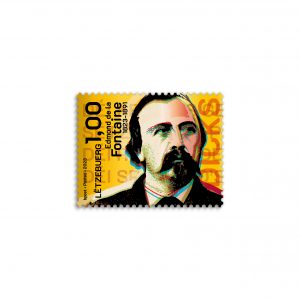
Special stamp
100 years of the Gëlle Fra
The Monument du Souvenir, known as the Gëlle Fra (Golden Lady) to Luxembourgers, stands in Place de la Constitution in the heart of Luxembourg City. It was inaugurated on 27 May 1923 as a memorial to fallen Luxembourg soldiers from the First World War. Today, the Gëlle Fra is a popular tourist attraction and a defining feature of the capital’s skyline.
The design of the structure is reminiscent of similar monuments of remembrance erected in numerous other cities (including Berlin, Vienna and London) at the time. Following its construction, Luxembourgers saw the Golden Lady as symbolizing their freedom and independence. It was this symbolism that led occupying German troops to seek to dismantle the monument in October 1940. After their plans partly failed on account of the resistance put up by Luxembourg’s population, the statue itself was pulled down and, for 35 years after that, the Gëlle Fra remained unaccounted for. It was not until January 1980 that she was found under the main stand of the Josy Barthel stadium in Luxembourg City. Following a restoration, she was inaugurated again in her original location on 23 June 1985 – Luxembourg’s National Day. Today, she is dedicated to the memory of the Luxembourgers who died in World War I and II and the Korean War.
In 2010, the Gëlle Fra was removed from her obelisk once again and travelled to the World Exhibition in Shanghai, where she graced the entrance to the Luxembourg Pavilion as a national symbol, much like Denmark’s Little Mermaid. The golden sheen of the statue, which weighs one-and-a-half tons, created an effective contrast to François Valentiny’s weathering steel structure.
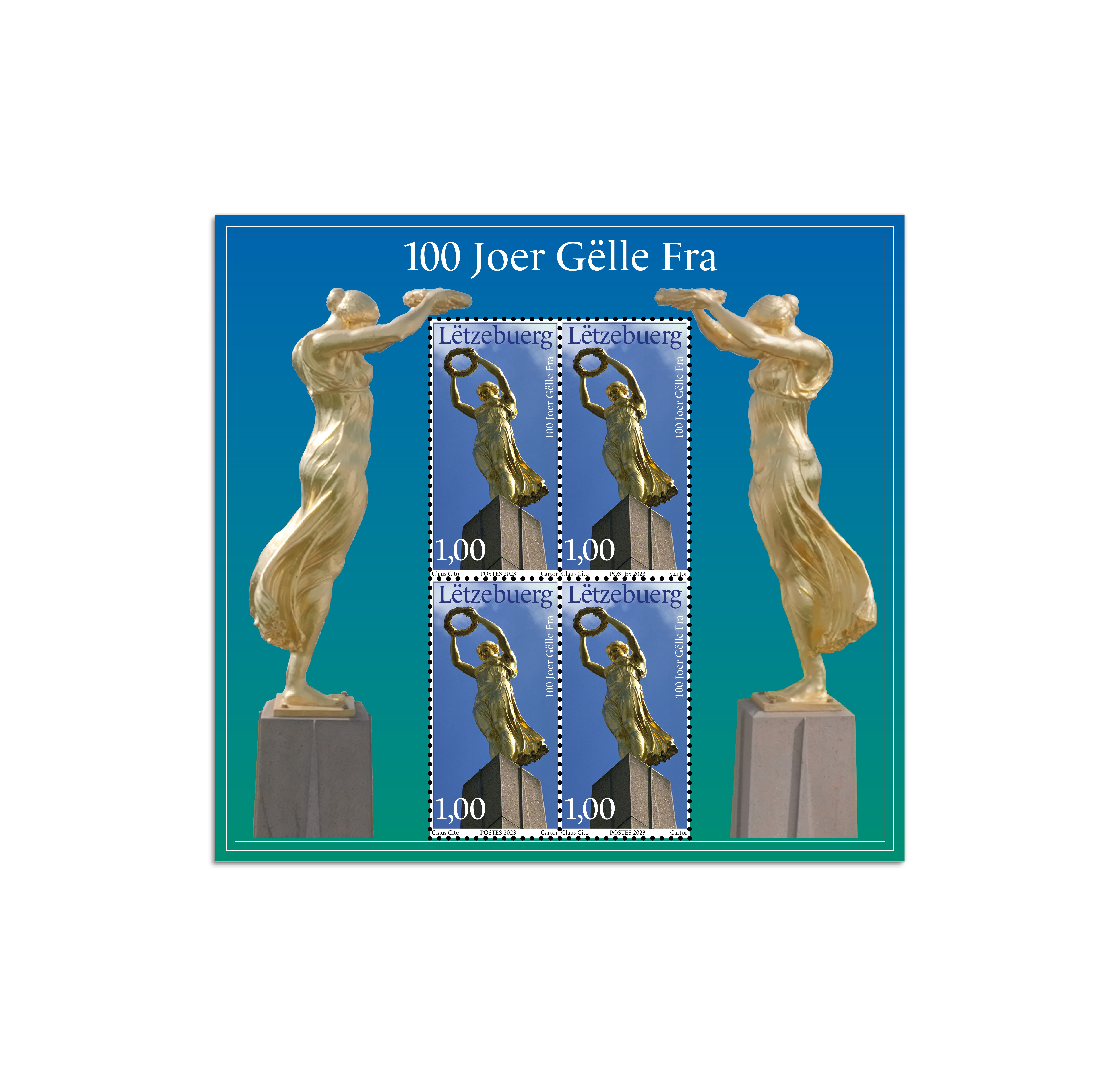
Special stamp
25-year of the European Institute of Cultural Routes
Established in 1998 in the framework of a political agreement between the Council of Europe and the Grand Duchy of Luxembourg, the European Institute of Cultural Routes (EICR) is the technical agency of the Cultural routes of the Council of Europe programme and hosts the Secretariat’s programme.
The Cultural Routes Programme was launched by the Council of Europe in 1987 as an invitation to discover the richness and diversity of European cultures and common cultural heritage.
While some among the 48 certified transnational Cultural Routes of the Council of Europe to date enhance arts, architecture, history and civilizations, others are dedicated to religious heritage, landscapes, and handicrafts.
Nine certified Cultural Routes cross Luxembourg: The Santiago de Compostela Pilgrim Routes, Saint Martin of Tours Route, Iter Vitis Route, European Route of Historic Thermal Towns, Fortified Towns of the Grande Region, European Route of Industrial Heritage, Liberation Route Europe, the European Route of Jewish Heritage and the Via Charlemagne.
The EICR provides advice, training and capacity building to certified and candidate cultural routes on methodology, certification criteria and preparation of applications for certification. It is responsible for the coordination of a network of over 20 European academic institutions aimed at encouraging research on Cultural Routes and hosts a specialised documentation centre at its headquarters located at Neumünster Abbey.
The European Institute of Cultural Routes is funded by the Ministry of Culture and benefits from close cooperation with the Ministry of Foreign Affairs and the Ministry of Economy (Directorate General for Tourism) of the Grand Duchy of Luxembourg.
Special stampp
EUROPA – Peace, the highest value of humanity
The original plan for 2023 was that EUROPA postage stamps of the participating European postal administrations would depict motifs from “Underwater Fauna & Flora” and that – as in previous years each country would implement its own interpretation of the overarching topic.
In April 2022, the Board of Directors of PostEurop then decided that the theme for EUROPA stamps in 2023 would be changed to “PEACE – the highest value of humanity”. This was in response to Ukrposhta’s proposal to “show solidarity with Ukraine and to promote the main value for all humanity – peace.” The decision corresponds to the basic idea of close cooperation and integration, as symbolized through the EUROPA postage stamps.
Special series
Asteroid Day – 2
The second motif of the Asteroid Day special series, which POST Philately is issuing over a three-year period, illustrates the theme of “Discovery”.
The swift discovery of near-Earth asteroids in our solar system that could threaten Earth is an important factor in ensuring the safety of our planet. Back in December 2014, at the launch of the worldwide Asteroid Day initiative, only 1% of the one million or so small near-Earth astronomical bodies had been discovered. A significant increase in the rate was therefore one of the key points of the 100x Declaration published at the event.
With the Asteroid Day special series, POST Philately is helping to raise awareness of the issue of asteroids among the general public.

 Åland
Åland  Faroe Islands
Faroe Islands  Gibraltar
Gibraltar  Greenland
Greenland  Guernsey
Guernsey  Isle of Man
Isle of Man  Jersey
Jersey  Liechtenstein
Liechtenstein  Luxembourg
Luxembourg  Malta
Malta  Monaco
Monaco  Vatican City
Vatican City 